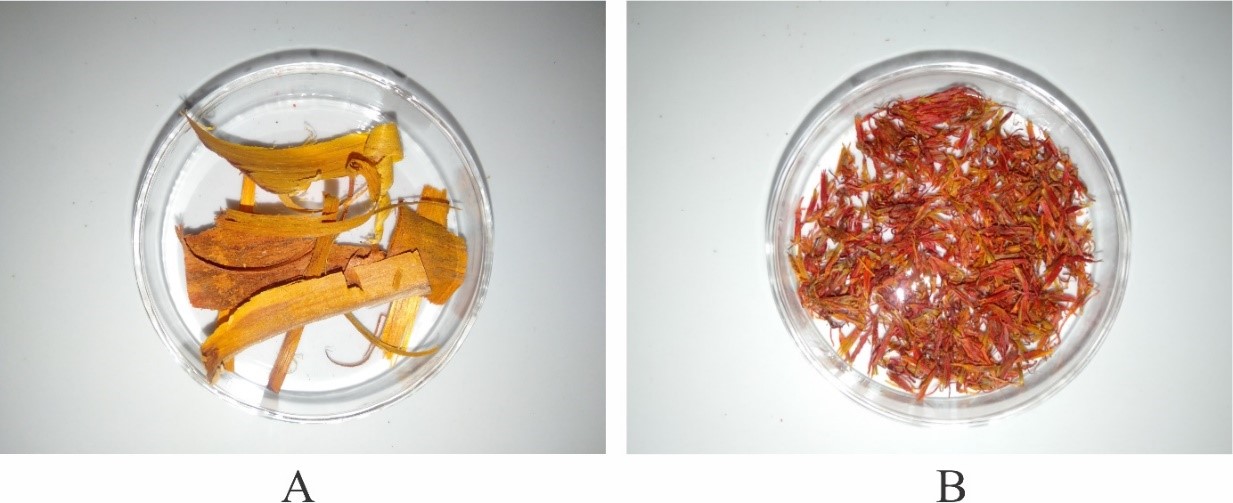The Usage of Biancaea Sappan and Crocus Sativus as Natural Dyes for the Liver Fluke, Fasciola Gigantica
Abstract
The herbs in Indonesia are rich in substances with medicinal effect as well as natural compounds for many purposes. The herbs are easily cultivated in the supporting climate and thus, guaranteeing it’s availability and sustainability. The aim of this study was to utilize Biancaea sappan and Crocus sativus as natural dye for Fasciola gigantica compared to commonly used dye, the acetocarmine. F. gigantica itself was frequently found as the liver fluke of cattle in Indonesia with significant economic losses. B. sappan and C. sativus were mashed and soaked in 100% glacial acetic acid overnight. The extracts were utilized to stain adult F. gigantica isolated from infected cattle in Ampel abattoir, Boyolali, Central Java, Indonesia. Acetocarmine 5.5% was a control during staining process. The results showed that structures and internal organs were pigmented in comparable degree with the control. Both of the B. sappan and C. sativus were successfully stained F. gigantica structures such as oral sucker, ventral sucker, uterine, eggs inside the uterine and testes as compared to acetocarmine. The pigmentation result showed that the C. sativus stained spina better than acetocarmine. The methods are eco-friendly and safe since the herbs do not have carcinogenic effect.
References
Ahmadieh, H., Kanavi, M. R., Moradian, S., & Bonyadi, M. H. J. (2018). Saffron for staining the anterior lens capsule. Journal of Cataract Refractive Surgery, 44(12), 1524-1525.
Akinloye, A., Illoh, H., & Olagoke, A. (2010). Screening of some indigenous herbal dyes for use in plant histological staining. Journal of Forestry Research, 21(1), 81-84.
Bhuyan, R., & Saikia, C. (2005). Isolation of colour components from native dye-bearing plants in northeastern India. Bioresource technology, 96(3), 363-372.
Bolhassani, A. (2018). Bioactive components of saffron and their pharmacological properties. Studies in Natural Products Chemistry, 58, 289-311.
Dapson, R., & Bain, C. (2015). Brazilwood, sappanwood, brazilin and the red dye brazilein: from textile dyeing and folk medicine to biological staining and musical instruments. Biotechnic Histochemistry, 90(6), 401-423.
Daryani, A., Sharif, M., & Meigouni, M. (2011). Staining of Fasciola hepatica by natural herbal dyes. Comparative clinical pathology, 20(4), 305-308.
Hanna, R. (2015). Fasciola hepatica: histology of the reproductive organs and differential effects of triclabendazole on drug-sensitive and drug-resistant fluke isolates and on flukes from selected field cases. Pathogens 4(3), 431-456.
Hariana, A. (2006). Tumbuhan Obat Dan Khasiatnya, Penebar Swadaya, Jakarta. In: Hal.
Haridwal, S., Malatji, M. P., & Mukaratirwa, S. (2021). Morphological and molecular characterization of Fasciola hepatica and Fasciola gigantica phenotypes from co-endemic localities in Mpumalanga and KwaZulu-Natal provinces of South Africa. Food Waterborne Parasitology 22, e00114.
Heidari, F., Shekari, F., Andalibi, B., Saba, J., Uberti, D., & Mastinu, A. (2022). Comparative effects of four plant growth regulators on yield and field performance of Crocus sativus L. Horticulturae, 8(9), 799.
Khazdair, M. R., Boskabady, M. H., Hosseini, M., Rezaee, R., & Tsatsakis, A. M. (2015). The effects of Crocus sativus (saffron) and its constituents on nervous system: A review. Avicenna journal of phytomedicine, 5(5), 376.
Kumar, N., Mehul, J., Das, B., & Solanki, J. (2015). Staining of Platyhelminthes by herbal dyes: An eco-friendly technique for the taxonomist. Veterinary world, 8(11), 1321.
Marhaba, Z., & Haniloo, A. (2018). Staining of parasitic helminths by extracts of Allium cepa, Juglans regia, and Rubia tinctorum: An approach to herbal dyes. Iranian Journal of Parasitology, 13(2), 293.
Nirmal, N. P., Rajput, M. S., Prasad, R. G., & Ahmad, M. (2015). Brazilin from Caesalpinia sappan heartwood and its pharmacological activities: A review. Asian Pacific Journal of Tropical Medicine, 8(6), 421-430.
Sutjaritjai, N., Panyadee, P., Phumthum, M., Inta, A., & Balslev, H. (2022). High diversity of medicinal uses of Thai legumes (Fabaceae) and their potential in public herbal medicine. Diversity, 14(8), 588.
Tamburini, D., Cartwright, C. R., Pullan, M., & Vickers, H. (2019). An investigation of the dye palette in Chinese silk embroidery from Dunhuang (Tang dynasty). Archaeological Anthropological Sciences, 11(4), 1221-1239.
Utami, N. K., Amperawati, M., & Rizki, M. I. (2022). Quantitative analysis of secondary metabolites and solvent optimization of Secang wood extract (Caesalpinia sappan L/Biancaea sappan) as disclosing agent. Jurnal Kesehatan Gigi, 9(1), 70-74.
Vahedi, M., Kabiri, M., Salami, S. A., Rezadoost, H., Mirzaie, M., & Kanani, M. R. (2018). Quantitative HPLC-based metabolomics of some Iranian saffron (Crocus sativus L.) accessions. Industrial Crops Products, 118, 26-29.
Zeibig, E. (2014). Clinical parasitology: A practical approach: Elsevier Health Sciences.







